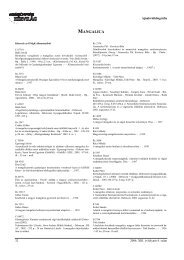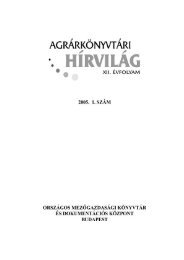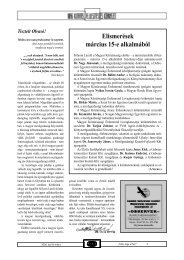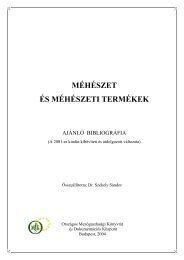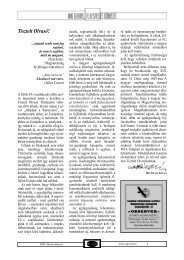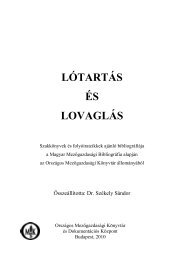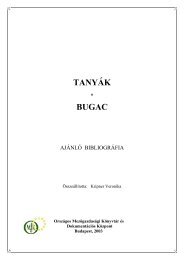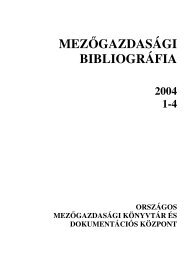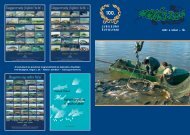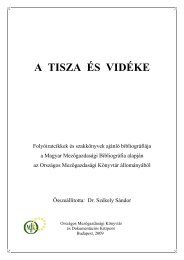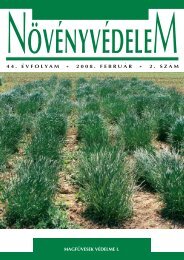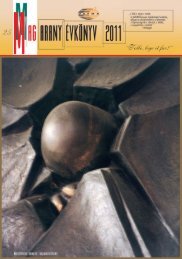hUNGARiAN AGRicUltURAl RESEARch
hUNGARiAN AGRicUltURAl RESEARch
hUNGARiAN AGRicUltURAl RESEARch
You also want an ePaper? Increase the reach of your titles
YUMPU automatically turns print PDFs into web optimized ePapers that Google loves.
Korzenszky, P., Judák, E.<br />
New technological possibilities for modifying particle<br />
size in feed production<br />
Quality of feed is one of the most<br />
decisive parameters of animal<br />
keeping technologies. The<br />
selection and determination of the<br />
proper nutrient composition is the<br />
task of those specialised in animal<br />
husbandry. Because of the<br />
different physiological characteristics<br />
of different animal species<br />
only the variety specific feeding<br />
can be the right solution. As a<br />
result of inter-specific differences,<br />
considerable differences exist<br />
between feed compositions. The<br />
amount, proportion and size of the<br />
ingredients have definite influence<br />
on the optimal feed utilization of<br />
the given animal species, the<br />
determination of which requires<br />
well-planned experimental design.<br />
The variety makes no difference<br />
in digestibility trials with<br />
pigs. Live weight is preferably<br />
maintained in the 40–80 kg range,<br />
but the use of animals with a body<br />
weight as much as 80–120 kg<br />
might also be required. The<br />
minimum number of pigs involved<br />
in the experiment is three and the<br />
literature suggests three parallel<br />
repetitions as customary in the<br />
technical field. The experiment is<br />
composed of a pre- and postsection<br />
of 5 days, respectively.<br />
Researchers KIDDER and<br />
MANNERS (1978) observed that<br />
it took an average of 20 hours for<br />
5% of the material to be excreted<br />
and 60 hours for 95% to be<br />
excreted. Animals have to be<br />
placed in special cages as the<br />
collection of the urine and faeces<br />
have to be permitted in a<br />
quantitative manner. The cages<br />
should be put in a room where a<br />
temperature of 18–20 o C, a relative<br />
humidity of 60–70% and suitable<br />
ventilation can be ensured.<br />
The direct digestibility trial,<br />
when the feed is provided alone, is<br />
based on the comparison of the<br />
amounts of nutrients ingested and<br />
excreted and the difference of the<br />
two is called apparent digestibility.<br />
Indirect digestibility trial is<br />
carried out giving a so-called basic<br />
feed to eat. The basic feed<br />
influences the digestibility of the<br />
feed to be tested and vica versa.<br />
This is what the literature calls<br />
combined digestibility. Table 1<br />
shows the composition of the<br />
recommended basic feed mix in<br />
indirect digestibility trials with<br />
pigs. [5]<br />
In order to produce basic feed it<br />
is necessary to comminute the<br />
individual components. This<br />
operation aims at permitting<br />
digestive fluids to have a better<br />
access to nutrients and to facilitate<br />
the mixing of feed components<br />
into a homogeneous mass. Comminution<br />
has the disadvantage that<br />
the oxidation of the plant oil that is<br />
no longer in a bound state will<br />
occur earlier than in the intact<br />
grain. Starch of feeds in a finelymilled<br />
state will be broken down<br />
too quickly in the rumen of<br />
ruminants, thereby creating an<br />
acidic pH in the rumen and this<br />
way disfavouring ruminal fermentation.<br />
Also, finely ground feeds<br />
that are susceptible to becoming<br />
sticky will adhere to the palate and<br />
will cause a poorer feed intake.<br />
A meal ground too fine will<br />
increase the risk of development of<br />
oesophageal ulcer in swine.<br />
According to the recommendations<br />
of the Hungarian Feed<br />
Codex published in 1990 the<br />
following particle sizes have to be<br />
used in the manufacturing of the<br />
given products.<br />
The effect of particle size on<br />
feed conversion in pig feeding is<br />
illustrated in Table 3.<br />
Data of the prescriptions (Table<br />
2) and the experimental results<br />
(Table 3) do not coincide in every<br />
case. In practice, following the<br />
prescriptions, the tendency is to try<br />
to produce a smaller particle size<br />
Table 1: Composition of recommended basic feed mix in indirect<br />
digestibility trials with pigs [5]<br />
Components %<br />
Corn 40.8<br />
Wheat 20.0<br />
Barley 20.0<br />
Extruded soy bean 16.0<br />
Other (MCP, feed lime, common salt, premix) 3.2<br />
1Szent István University, Faculty of Mechanical Engineering<br />
Hungarian Agricultural Research 2009/3–4 13



